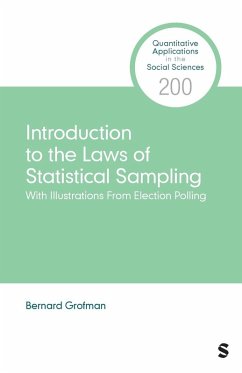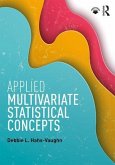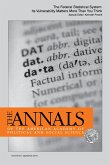Bernard Grofman
Introduction to the Laws of Statistical Sampling
With Illustrations From Election Polling
Bernard Grofman
Introduction to the Laws of Statistical Sampling
With Illustrations From Election Polling
- Broschiertes Buch
- Merkliste
- Auf die Merkliste
- Bewerten Bewerten
- Teilen
- Produkt teilen
- Produkterinnerung
- Produkterinnerung
A concise, intuitive monograph that demystifies statistical sampling theory-especially as applied to elections and survey research-using real-world examples, simulations, and Excel-based tools. It's designed to be accessible to readers with only high school algebra.
Andere Kunden interessierten sich auch für
![Applied Multivariate Statistical Concepts Applied Multivariate Statistical Concepts]() Debbie L Hahs-VaughnApplied Multivariate Statistical Concepts130,99 €
Debbie L Hahs-VaughnApplied Multivariate Statistical Concepts130,99 €![Winnipeg, Manitoba, the Prairie City, Its Wonderful History and Future Prospects [microform]: a General Historical, Statistical and Descriptive Review Winnipeg, Manitoba, the Prairie City, Its Wonderful History and Future Prospects [microform]: a General Historical, Statistical and Descriptive Review]() AnonymousWinnipeg, Manitoba, the Prairie City, Its Wonderful History and Future Prospects [microform]: a General Historical, Statistical and Descriptive Review15,99 €
AnonymousWinnipeg, Manitoba, the Prairie City, Its Wonderful History and Future Prospects [microform]: a General Historical, Statistical and Descriptive Review15,99 €![The Federal Statistical System The Federal Statistical System]() Kenneth PrewittThe Federal Statistical System70,99 €
Kenneth PrewittThe Federal Statistical System70,99 €![A Statistical Study Of American Cities By Students Of Reed College, Under The Direction Of William Fielding Ogburn A Statistical Study Of American Cities By Students Of Reed College, Under The Direction Of William Fielding Ogburn]() A Statistical Study Of American Cities By Students Of Reed College, Under The Direction Of William Fielding Ogburn15,99 €
A Statistical Study Of American Cities By Students Of Reed College, Under The Direction Of William Fielding Ogburn15,99 €![Historical and Statistical Memoir of the Ghazeepoor District, Part 1 Historical and Statistical Memoir of the Ghazeepoor District, Part 1]() Wilton OldhamHistorical and Statistical Memoir of the Ghazeepoor District, Part 124,99 €
Wilton OldhamHistorical and Statistical Memoir of the Ghazeepoor District, Part 124,99 €![Statistical Concepts for the Behavioral Sciences Statistical Concepts for the Behavioral Sciences]() Harold O KiessStatistical Concepts for the Behavioral Sciences76,99 €
Harold O KiessStatistical Concepts for the Behavioral Sciences76,99 €![Two Reports Addressed To His Majesty's Commissioners Appointed To Inquire Into The Administration And Operation Of The Poor Laws Two Reports Addressed To His Majesty's Commissioners Appointed To Inquire Into The Administration And Operation Of The Poor Laws]() Charles Hay CameronTwo Reports Addressed To His Majesty's Commissioners Appointed To Inquire Into The Administration And Operation Of The Poor Laws20,99 €
Charles Hay CameronTwo Reports Addressed To His Majesty's Commissioners Appointed To Inquire Into The Administration And Operation Of The Poor Laws20,99 €-
-
-
A concise, intuitive monograph that demystifies statistical sampling theory-especially as applied to elections and survey research-using real-world examples, simulations, and Excel-based tools. It's designed to be accessible to readers with only high school algebra.
Produktdetails
- Produktdetails
- Quantitative Applications in the Social Sciences
- Verlag: SAGE Publications Inc
- Seitenzahl: 144
- Erscheinungstermin: 14. Februar 2026
- Englisch
- Abmessung: 215mm x 139mm
- ISBN-13: 9798348832308
- Artikelnr.: 75422579
- Herstellerkennzeichnung
- Libri GmbH
- Europaallee 1
- 36244 Bad Hersfeld
- gpsr@libri.de
- Quantitative Applications in the Social Sciences
- Verlag: SAGE Publications Inc
- Seitenzahl: 144
- Erscheinungstermin: 14. Februar 2026
- Englisch
- Abmessung: 215mm x 139mm
- ISBN-13: 9798348832308
- Artikelnr.: 75422579
- Herstellerkennzeichnung
- Libri GmbH
- Europaallee 1
- 36244 Bad Hersfeld
- gpsr@libri.de
Bernard Grofman is Distinguished Research Professor of Political Science and Social Psychology, School of Social Sciences, University of California, Irvine. A member of the American Academy of Arts and Science, he was the inaugural Jack W. Peltason Endowed Chair of Democracy Studies at UCI and has also been an Adjunct Professor of Economics at UCI and a visiting scholar-in-residence at universities in nearly a dozen countries.
Series Editor Introduction
Acknowledgements
About the Author
Chapter 1: An Overview
1.1 Distinctive Features of the Approach to Sampling and Inference in This
Volume
1.2 The Structure of this Book
1.3 Notation
1.4 Basic Metrics
APPENDIX to Chapter 1: A Few Useful EXCEL Functions and Tools
Chapter 2: Sampling Distributions
2.1 Ideal Types of Univariate Data Distributions
2.2 The Normal Distribution and the Standardized Normal Distribution
2.3 Approximately Normal Distributions
2.4 Cumulative Distributions and Finding Percentile Ranks Using EXCEL
2.5 The Binomial Distribution
2.6 The t-Distribution
2.7 Other Approximately Normal Distributions
2.8 Skewness and Kurtosis
2.9 Not all Univariate Distributions are Approximately Normal
APPENDIX to Chapter 2: Theorem Proofs
Chapter 3: Sampling and Hypothesis Testing
3.1 Sampling and Hypothesis Testing
3.2 An Inventory of the Ten Laws of Statistical Sampling
3.3 Sampling From a Normal Distribution with Binomial Variance
APPENDIX to Chapter 3: Distinguishing the Standard Error of the Mean From
the Sample Error
Chapter 4: Using EXCEL to Answer the First Five of our Six Questions
4.1 Five Paradigmatic Questions About Sampling in Two-Candidate Elections
Chapter 5: Difference of Means
5.1 Question 6. "When can we reject the claim that two distributions are
drawn from the same population?"
5.2 Experiments as the Basis for Generating Data for a Difference of Means
Test
5.3 Statistical Significance versus Substantive Significance: The
Importance of Sample Size
5.4 Illustrating Ideological Polarization and Partisan Sorting with Polling
Data
5.5 Warnings about Causation and Selection Bias Effects
Chapter 6: Unifying Perspectives on Sampling and Hypothesis Testing
Involving a Univariate Distribution
6.1 Similarities Across Statistical Tools
6.2 Concluding Thoughts
APPENDIX 1 to Chapter 6 - Parallels Between the Ideas in this Book and
Regression Analysis
APPENDIX 2 to Chapter 6: A Short List of Suggestions for Further Reading
References
Index
Acknowledgements
About the Author
Chapter 1: An Overview
1.1 Distinctive Features of the Approach to Sampling and Inference in This
Volume
1.2 The Structure of this Book
1.3 Notation
1.4 Basic Metrics
APPENDIX to Chapter 1: A Few Useful EXCEL Functions and Tools
Chapter 2: Sampling Distributions
2.1 Ideal Types of Univariate Data Distributions
2.2 The Normal Distribution and the Standardized Normal Distribution
2.3 Approximately Normal Distributions
2.4 Cumulative Distributions and Finding Percentile Ranks Using EXCEL
2.5 The Binomial Distribution
2.6 The t-Distribution
2.7 Other Approximately Normal Distributions
2.8 Skewness and Kurtosis
2.9 Not all Univariate Distributions are Approximately Normal
APPENDIX to Chapter 2: Theorem Proofs
Chapter 3: Sampling and Hypothesis Testing
3.1 Sampling and Hypothesis Testing
3.2 An Inventory of the Ten Laws of Statistical Sampling
3.3 Sampling From a Normal Distribution with Binomial Variance
APPENDIX to Chapter 3: Distinguishing the Standard Error of the Mean From
the Sample Error
Chapter 4: Using EXCEL to Answer the First Five of our Six Questions
4.1 Five Paradigmatic Questions About Sampling in Two-Candidate Elections
Chapter 5: Difference of Means
5.1 Question 6. "When can we reject the claim that two distributions are
drawn from the same population?"
5.2 Experiments as the Basis for Generating Data for a Difference of Means
Test
5.3 Statistical Significance versus Substantive Significance: The
Importance of Sample Size
5.4 Illustrating Ideological Polarization and Partisan Sorting with Polling
Data
5.5 Warnings about Causation and Selection Bias Effects
Chapter 6: Unifying Perspectives on Sampling and Hypothesis Testing
Involving a Univariate Distribution
6.1 Similarities Across Statistical Tools
6.2 Concluding Thoughts
APPENDIX 1 to Chapter 6 - Parallels Between the Ideas in this Book and
Regression Analysis
APPENDIX 2 to Chapter 6: A Short List of Suggestions for Further Reading
References
Index
Series Editor Introduction
Acknowledgements
About the Author
Chapter 1: An Overview
1.1 Distinctive Features of the Approach to Sampling and Inference in This
Volume
1.2 The Structure of this Book
1.3 Notation
1.4 Basic Metrics
APPENDIX to Chapter 1: A Few Useful EXCEL Functions and Tools
Chapter 2: Sampling Distributions
2.1 Ideal Types of Univariate Data Distributions
2.2 The Normal Distribution and the Standardized Normal Distribution
2.3 Approximately Normal Distributions
2.4 Cumulative Distributions and Finding Percentile Ranks Using EXCEL
2.5 The Binomial Distribution
2.6 The t-Distribution
2.7 Other Approximately Normal Distributions
2.8 Skewness and Kurtosis
2.9 Not all Univariate Distributions are Approximately Normal
APPENDIX to Chapter 2: Theorem Proofs
Chapter 3: Sampling and Hypothesis Testing
3.1 Sampling and Hypothesis Testing
3.2 An Inventory of the Ten Laws of Statistical Sampling
3.3 Sampling From a Normal Distribution with Binomial Variance
APPENDIX to Chapter 3: Distinguishing the Standard Error of the Mean From
the Sample Error
Chapter 4: Using EXCEL to Answer the First Five of our Six Questions
4.1 Five Paradigmatic Questions About Sampling in Two-Candidate Elections
Chapter 5: Difference of Means
5.1 Question 6. "When can we reject the claim that two distributions are
drawn from the same population?"
5.2 Experiments as the Basis for Generating Data for a Difference of Means
Test
5.3 Statistical Significance versus Substantive Significance: The
Importance of Sample Size
5.4 Illustrating Ideological Polarization and Partisan Sorting with Polling
Data
5.5 Warnings about Causation and Selection Bias Effects
Chapter 6: Unifying Perspectives on Sampling and Hypothesis Testing
Involving a Univariate Distribution
6.1 Similarities Across Statistical Tools
6.2 Concluding Thoughts
APPENDIX 1 to Chapter 6 - Parallels Between the Ideas in this Book and
Regression Analysis
APPENDIX 2 to Chapter 6: A Short List of Suggestions for Further Reading
References
Index
Acknowledgements
About the Author
Chapter 1: An Overview
1.1 Distinctive Features of the Approach to Sampling and Inference in This
Volume
1.2 The Structure of this Book
1.3 Notation
1.4 Basic Metrics
APPENDIX to Chapter 1: A Few Useful EXCEL Functions and Tools
Chapter 2: Sampling Distributions
2.1 Ideal Types of Univariate Data Distributions
2.2 The Normal Distribution and the Standardized Normal Distribution
2.3 Approximately Normal Distributions
2.4 Cumulative Distributions and Finding Percentile Ranks Using EXCEL
2.5 The Binomial Distribution
2.6 The t-Distribution
2.7 Other Approximately Normal Distributions
2.8 Skewness and Kurtosis
2.9 Not all Univariate Distributions are Approximately Normal
APPENDIX to Chapter 2: Theorem Proofs
Chapter 3: Sampling and Hypothesis Testing
3.1 Sampling and Hypothesis Testing
3.2 An Inventory of the Ten Laws of Statistical Sampling
3.3 Sampling From a Normal Distribution with Binomial Variance
APPENDIX to Chapter 3: Distinguishing the Standard Error of the Mean From
the Sample Error
Chapter 4: Using EXCEL to Answer the First Five of our Six Questions
4.1 Five Paradigmatic Questions About Sampling in Two-Candidate Elections
Chapter 5: Difference of Means
5.1 Question 6. "When can we reject the claim that two distributions are
drawn from the same population?"
5.2 Experiments as the Basis for Generating Data for a Difference of Means
Test
5.3 Statistical Significance versus Substantive Significance: The
Importance of Sample Size
5.4 Illustrating Ideological Polarization and Partisan Sorting with Polling
Data
5.5 Warnings about Causation and Selection Bias Effects
Chapter 6: Unifying Perspectives on Sampling and Hypothesis Testing
Involving a Univariate Distribution
6.1 Similarities Across Statistical Tools
6.2 Concluding Thoughts
APPENDIX 1 to Chapter 6 - Parallels Between the Ideas in this Book and
Regression Analysis
APPENDIX 2 to Chapter 6: A Short List of Suggestions for Further Reading
References
Index



![Winnipeg, Manitoba, the Prairie City, Its Wonderful History and Future Prospects [microform]: a General Historical, Statistical and Descriptive Review Winnipeg, Manitoba, the Prairie City, Its Wonderful History and Future Prospects [microform]: a General Historical, Statistical and Descriptive Review](https://bilder.buecher.de/produkte/65/65566/65566883m.jpg)




